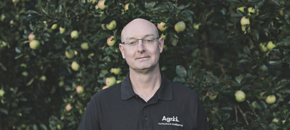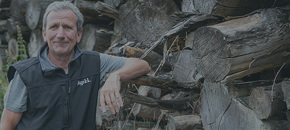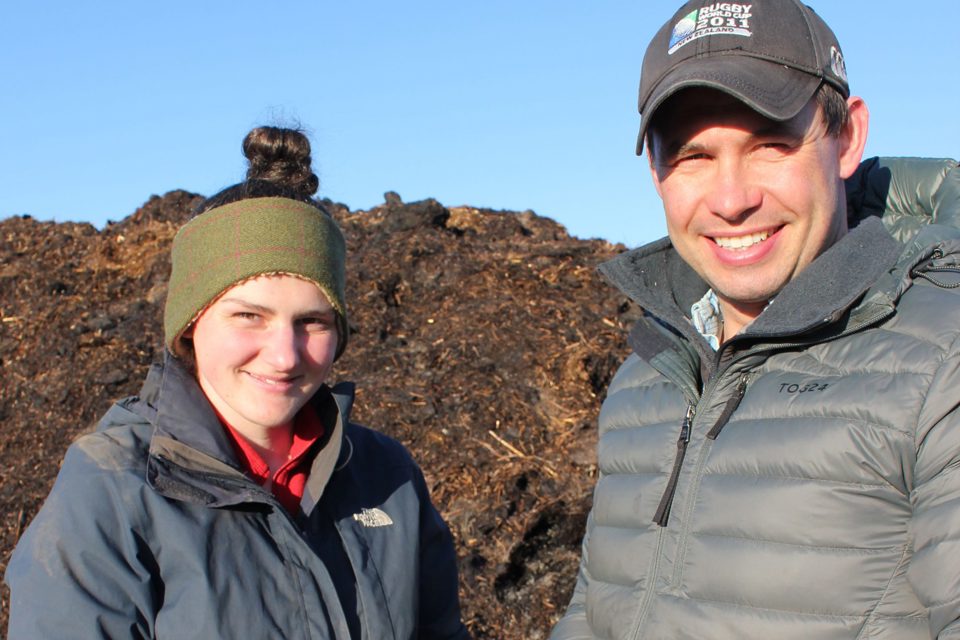
Soil-centred Worcestershire sustainability drive
Case Study - 20.07.22
Home-made compost, massively reduced tillage and determined cover cropping have been central to the single-minded drive to improve the arable sustainability of the Green Horizons Network farm at Salford Lodge, Pitchill just outside Evesham, over the past decade.
A combination of challenging silty clay land contract-farmed with heavy kit for many years and lighter sandy gravel ground that continues to be rented out for field vegetable production, haven’t made the task any easier. And Tom Hughes’ effort to match both the productivity and low environmental impact of the substantial broiler business developed and run by his parents, Malcom and Liz remains very much ‘a work in progress’.
Even so, the improvements he and his Agrii agronomist, Kathryn Styan have made so far are obvious in huge reductions in blackgrass and brome problems, in far better structured and more resilient soils, and in the all-important bottom line – not to mention results from the first year of ADAS YEN Zero benchmarking.
Fresh from working on a progressive Wiltshire downland unit, Tom came back to the family business in 2013 to take the land in-hand. He recalls ‘jumping in at the deep end’ with the 120ha of heavy ground not in vegetable production full of enthusiasm for the no-till approach.
“With all the land rented out until then, we had no machinery at all,” he explains. “The ground had been demanding increasing amounts of horsepower to support deep-working and power-harrowing. Unsurprisingly too, given the poor soil conditions, black-grass counts were knocking on the door of 1500 heads/m2.
“This certainly focused the mind, and drew us to Agrii’s heavy land work at Stow Longa which has heavily influenced our thinking. We were tempted to do a reset with the plough. Instead, though, we decided on a winter of intensive multiple stale seedbeds followed by five years of no-till spring cropping. At the same time, we mole-ploughed the whole area to link-in with the drains my parents installed in the ‘eighties.
“After alternating spring wheats and linseeds followed by canary seed, our first crop of winter wheat in 2019 averaged 10.75t/ha with no black-grass in sight. OK, it was a good year for wheat, but this clearly proved the value of our soil-centred approach.”
In 2016, the vegetable ground was brought back into the rotation to address worryingly low organic matters and poor structure making the soils very prone to capping in the wet and baking hard in the dry. Good quality land with irrigation is at a premium locally. So, it makes sound economic sense to keep renting it out. But field vegetable growing is hardly the most compatible with a no-till approach. By cropping the ground themselves three years in every four and working closely with their vegetable-growing partners, the team has made sure their soil improvement efforts are not compromised by the land’s year in vegetables.
“They’ve been very receptive to this,” points out Tom. “We now have full overwinter cover ahead of every spring-sown crop, together with a programme of sustained annual organic matter addition.
“When we hand ground back for the vegetables – generally after a winter cereal – our partners spread certified green waste. We then establish the winter cover with a mix of species designed to suit their following crop on contract. At the same time, we are working closely with them to reduce their tillage in a number of ways.”
Integrating this land into the arable business instead of leaving it permanently rented out has added a further complication. Poultry litter from the family’s 10 broiler sheds has been important in improving the rest of the acreage, but this cannot be applied directly within the vegetable rotation.
To address this issue, Tom has developed his own simple but very effective composting operation. This involves mixing the litter with chopped straw from the farm’s 100ha of soft wheat – grown for the broiler rations – and grass silage from its 35ha of zero input grassland – which has to be removed annually under the Stewardship agreement.
“The grass silage adds extra green material which aids the composting process,” notes Kathryn Styan. “With a nicely balanced analysis, including 24kg N/tonne and good amounts of phosphate, potash, magnesium, calcium and sulphur, the 1000 tonnes made annually has proved a much better manure than pure poultry litter.
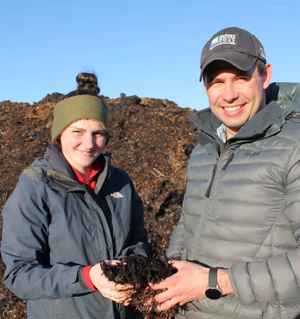
Testing the latest batch of Salford Lodge compost
“It’s also just right for spring top dressing the winter wheat, overcoming the fundamental conflict between direct drilling and the requirement to incorporate organic manures. The active worm populations we now have in our soils naturally incorporated it in remarkably short order following application.
“We’ve seen huge benefits from using the compost as widely as we can alongside our determined least cultivation, continuous green cover approach. Organic matter levels are up to 8% in places and all the soils both hold water and drain infinitely better. Ground we could seldom walk in the winter without getting covered in mud or sinking-in, now scarcely leaves a mark on our boots, or on the soil.
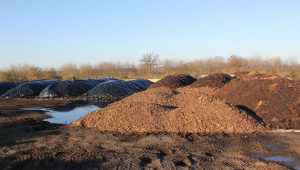
Forced to cover over fresh poultry manure by avian flu regulations, Tom Hughes has been trying out Bokashi anearobic compost-making alongside his traditional practice this year.
“Organic manures providing 20-35% of the nitrogen we apply to our wheat is a big financial win these days. What’s more, we only used 180kg/ha of N overall on wheat averaging 9.8t/ha last season – 40kg/ha less than the year before.
“Results from the six fields of winter oats, winter wheat and forage maize we entered into the initial year of YEN Zero last season as part of the Green Horizons initiative are also very encouraging,” she adds. “The yields Tom has been averaging for each crop are at the top end of the project results, whilst the greenhouse gas emissions remain some of the lowest. All crops scored especially well for emissions from the key areas of operations and synthetic nitrogen production and application.”
Operational emissions reflect the extent to which cultivations have been minimised at Salford Lodge. Central to this is the 4.8m trailed Weaving GD drill used for all arable and cover crop sowing, and chosen for the effectiveness of its angled double disc coulter system in cutting and closing the slot as well as the accuracy of its seed placement.
“Soil improvements are allowing us direct drill more crops more effectively every year,” says Tom. “Our ground is becoming much more resilient to both weather and machinery too. But we still need to relieve the panning which is inevitable in our high silty clay soils. We also have to eliminate the system of beds used for vegetable growing and incorporate substantial crop residues.”
“We have three bits of the cultivation kit which we use as sparingly as possible – all from our local friends at Weaving. We started off by retro-fitting their ultra-low disturbance legs to a Subdisc for deeper working but now rely far more on the LD Topsoiler at just 6”. After vegetables the light-weight Shortdisc is our first choice for tackling the residues left behind.”
While they accept some cultivation will remain inevitable at Salford Lodge for the foreseeable future, in no way does this lessen Tom and Kathryn’s enthusiasm for cover crops. From a simple combination of mustard, black oats and tillage radish, they are currently trying a twelve-way mix based on vetch, sunflower and black oats with four species of clover, fodder and tillage radish, buckwheat and phacelia on the heavy ground ahead of linseed, and on the light ground ahead of maize.
In addition to widening the diversity of rooting and biology, they see this as the best insurance against changing conditions, knowing that some elements of the mix will always establish well but they are likely to be different ones in different seasons.
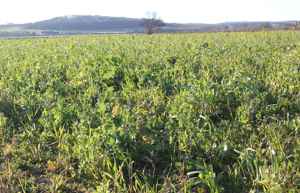
A good cover mix after field vegetables
“We match our covers very much to the time of sowing as well as the following crop,” Kathryn insists. “Early harvested vegetables give the best opportunity for them to work ahead of either autumn-sown cereals or maize in the spring so we tend to use more complex mixes here. Even after vegetable crops coming off as late as October, though, we think it’s important to get something in – generally something simpler and cheaper at a higher seed rate. This is more to protect the ground from rain impact than to do much good structurally.”
With the particular challenge of making the 70ha of maize they grow annually for a local AD plant more sustainable, the Salford Lodge team tried establishing a crop into a more permanent clover mix last season.
They set up the ground with the LD topsoiler, applied compost then matched the drill to the LD’s leg spacing with GPS and blocked-off coulters. Not having a precision drill, however, made for very uneven sowing, leading to much poorer yields than the 40t/ha they generally harvest. Serious weed problems which had to be sprayed off also meant the clover was lost.
Undeterred by this, Tom and Kathryn team remain both determined to maintain their pace of their sustainability improvement – especially as far as maize is concerned – and excited by the opportunities they see to do so.

Vastly improved soils under a multi-species cover
Amongst their particularly positive experiences on the cereal side, they’ve been harnessing variable rate seeding to even-up field performance; using LiquiSafe liquid fertiliser treatment to eliminate at least one spring pass; better balancing crop nutrition to improve overall nutrient use efficiency; employing promising biologicals at T0 and T3 to reduce reliance on fungicides; and yield mapping and Gatekeeper to track their progress.
“We are putting lots of little things together within our broader soil-focussed approach to improve what we do in crop production alongside and as closely as we can with all the other environmental and carbon improvements being made by our broader family business,” concludes Tom. “Most obvious here are 15ha of short rotation willow coppice and a wood-chipping operation; 10 biomass boilers 23 air source heat pumps and a new ground source installation; and a 10ha array of solar panels.
“Having my brother George so heavily involved at the sharp end of a renewable energy and carbon sequestration business is a great help here, making what we are doing part of a truly integrated family-wide effort.”
Agrii Case Studies: Stories of farmers we’ve worked with
Join Our Community

Agrii X
We love engaging with clients and partners. Give us a follow and let's share stories for the community.

Agrii Instagram
A picture paints a thousand words. Follow us on Instagram to see what we are up to.

Agrii Facebook
Follow us on the worlds biggest social media site for the latest news and events straight to your feed.

Agrii LinkedIn
If you are all about the business, connect with us on LinkedIn to build your network
Stay In Touch

Newsletter Sign-Up
Receive email updates on topical news and information from around Agrii and UK Farming.

Listen To Our Podcasts
Listen to the Tramlines Podcast. Fortnightly chat about agriculture and trials with your host Tony Smith.

Agrii Insights
Read essential agri intelligence for profitable farming.

Find an Event
Join us for our upcoming events and tours.


